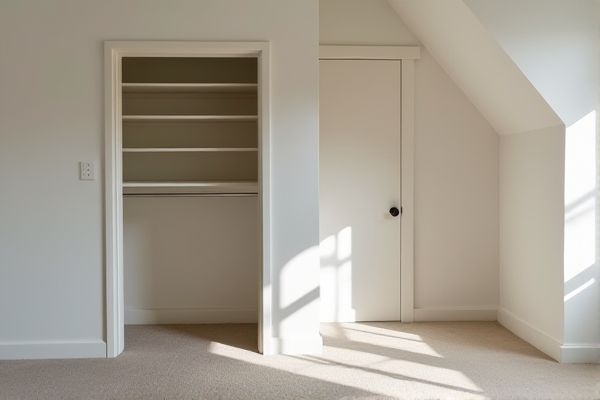
Open closets in attics offer easy access and better ventilation, reducing moisture buildup and making it simpler to organize your storage items. Closed closets provide a more polished look and protect belongings from dust and pests; explore the rest of this article to decide which option suits your attic and lifestyle best.
Table of Comparison
| Feature | Open Closet | Closed Closet (Attic) |
|---|---|---|
| Accessibility | Easy and quick access; no doors or barriers | Limited access; usually requires stairs or ladder |
| Storage Capacity | Moderate; visible and limited by open space | High; utilizes unused attic space efficiently |
| Ventilation | Good airflow; reduces moisture buildup | Depends on attic ventilation; risk of humidity |
| Protection from Dust & Dirt | Exposed; higher dust accumulation | Enclosed; better protection for stored items |
| Security | Low; items are visible and accessible | Higher; enclosed space restricts access |
| Cost | Lower; minimal construction required | Higher; may require insulation and structural modifications |
| Aesthetic Impact | Open design; integrates with room decor | Hidden; no impact on room aesthetics |
Introduction to Open Closets vs Closed Closets in Attics
Open closets in attics offer easy access and improved ventilation, reducing moisture buildup and preventing mold growth. Closed closets provide better protection from dust, pests, and temperature fluctuations, preserving stored items more effectively. Your choice depends on the attic's climate and the type of belongings you plan to store.
Space Utilization: Open vs Closed Closet Designs
Open closets maximize space utilization by providing easy access and visibility, allowing you to organize and retrieve items quickly while promoting airflow to prevent moisture buildup. Closed closets, such as attic designs, offer protected storage that can house seasonal or less frequently used items, optimizing vertical space and reducing clutter in living areas. Selecting between open or closed closets depends on your need for accessibility versus protection and the specific dimensions of your space.
Aesthetic Appeal: Enhancing Attic Interiors
Open closets in attics create a modern, airy atmosphere by showcasing neatly arranged clothing and accessories, enhancing the visual appeal of the space with organized displays. Closed closets, on the other hand, offer a cleaner, minimalist look by concealing storage areas, which helps maintain a clutter-free and streamlined attic interior. Your choice depends on whether you prefer the charm of visible organization or the sleekness of hidden storage to elevate your attic's aesthetic.
Organization and Accessibility Comparison
Open closets provide easy access and visibility, allowing users to quickly find and retrieve items without obstruction, ideal for frequently used clothing or accessories. Closed closets in attics offer protection from dust and pests but often require additional effort to organize due to limited lighting and tighter spaces, which can hinder quick accessibility. Efficient organization in closed attic closets typically necessitates labeled storage bins and strategic shelving to maximize space and maintain order.
Ventilation and Airflow Considerations
Open closets offer superior ventilation and airflow compared to closed attic closets, reducing moisture buildup and preventing mold growth. Closed attic closets often trap heat and humidity, which can lead to poor air circulation and increased risk of musty odors or structural damage. Ensuring proper airflow in your storage spaces helps maintain the quality of stored items and supports healthier indoor air conditions.
Protection from Dust and Pests
Closed closets, especially those with sealed doors and airtight construction, provide superior protection from dust and pests compared to open closets. Attic closets with well-fitted doors help prevent the infiltration of airborne dust particles and rodents, reducing the risk of damage and contamination to stored items. Open closets allow dust accumulation and easier access for insects and small pests, making them less ideal for long-term storage.
Cost Implications of Open vs Closed Closets
Open closets typically involve lower installation costs due to simpler construction and fewer materials, making them a budget-friendly choice for homeowners. Closed closets, especially attic types, require framing, drywall, and often custom doors, which increase expenses but provide better protection against dust and improved organization. Your decision should balance initial cost savings with long-term maintenance and usability preferences.
Customization and Flexibility Options
Open closets in attics offer superior customization and flexibility, allowing you to easily adjust shelving, hanging rods, and storage compartments to fit your specific needs. Closed closets, while providing a more finished and polished look, limit flexibility due to fixed walls and doors, restricting modifications and storage reconfiguration. Choosing an open closet ensures maximum adaptability for evolving storage demands and personalized organization.
Maintenance and Cleaning Differences
Open closets in attics typically require more frequent dusting and cleaning due to their exposure, allowing dirt and debris to accumulate on clothing and stored items. Closed closets provide a sealed environment that reduces dust infiltration and helps protect your belongings from dirt, pests, and moisture, thereby lowering overall maintenance efforts. Regular inspection of closed closets is still necessary to prevent mold and mildew, especially in humid attic conditions.
Which Closet Style Suits Your Attic Best?
Open closets in attics maximize visibility and accessibility, ideal for showcasing seasonal items and frequently used belongings, while closed closets provide protection from dust and temperature fluctuations, preserving delicate fabrics and stored valuables. Attics with adequate ventilation and lighting benefit from open closets, whereas spaces prone to humidity or fluctuating temperatures favor closed closets to maintain item integrity. Considerations such as storage needs, climate control, and spatial layout determine which closet style best suits your attic environment.
 homyna.com
homyna.com